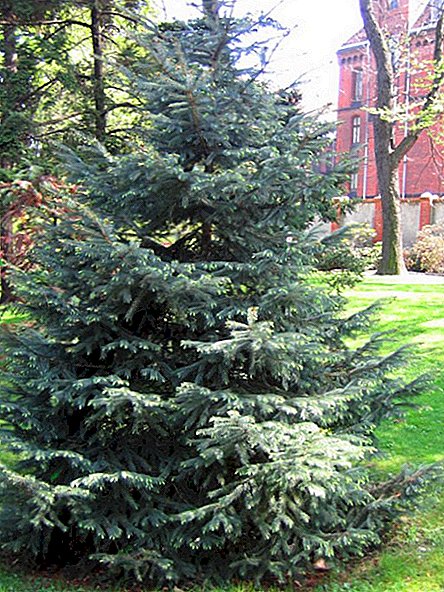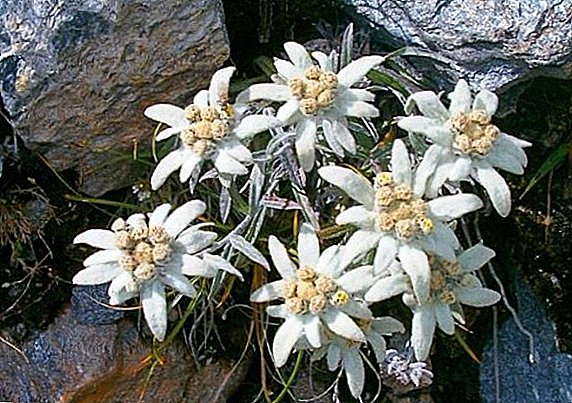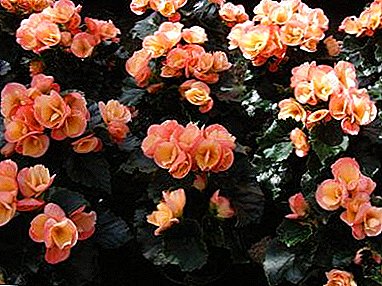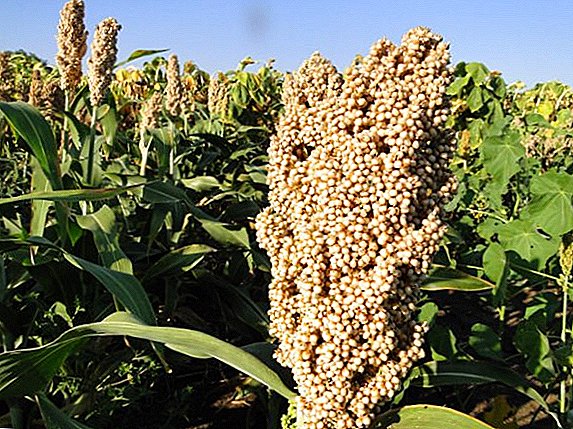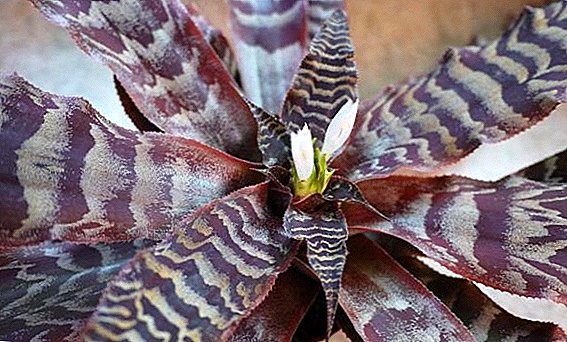 Cryptanthus belongs to the perennial indoor plants and has practically no stem, so people often call it an "earth star". Its white flowers are hidden in the foliage, which is collected in a beautiful outlet and looks very unusual. In the article we will consider the description of the flower, the main features of growing cryptanthus and its reproduction in the home, the subtleties of care, as well as methods to combat diseases and pests.
Cryptanthus belongs to the perennial indoor plants and has practically no stem, so people often call it an "earth star". Its white flowers are hidden in the foliage, which is collected in a beautiful outlet and looks very unusual. In the article we will consider the description of the flower, the main features of growing cryptanthus and its reproduction in the home, the subtleties of care, as well as methods to combat diseases and pests.
Botanical description of the plant
Cryptanthus is home to the rainforests of Eastern Brazil. The flower hit the territory of Europe only in the XIX century, but today it can be found on the windowsills of many amateur growers.
Consider the botanical description of a flower:
- The plant is a perennial, belongs to the family of bromeliyevs. When grown in room conditions, its height does not exceed 35-40 cm.
- The root system is fragile and has a small size, but branched.
- The leaves are long and dense, gathered in a voluminous rosette having a star shape. Depending on the type of plant, its leaves reach 10-40 cm in length and 3-4 cm in width.
- Depending on the type, the leaves of the flower may be green or multi-colored, consisting of green, yellow, red or white stripes. The bottom of the sheet is covered with scales.

- The flowering period falls on the second half of summer. The peduncle is located in the center of the rosette and is often covered with leaves from above.
- A small spike inflorescence consists of several white flowers, the shape of which resembles a bell. Long stamens of bright yellow color protrude from each flower.
- The flowering ends at about the end of August, and in the place of the withered buds small boxes with seeds appear.
- Cryptanthus is poisonous, so it is not recommended to grow it in a house where there are small children and pets.
Main types
The genus of cryptanthus includes more than 20 species and several hybrids. For cultivation in the indoor environment is usually chosen ornamental types of cryptanthus, with multi-colored striped leaves.
Did you know? Translated from the Greek word "cryptanthus" means "hidden flower."
Consider the main varieties of this plant with a brief description of each species:
- Cryptanthus stemless (Cryptanthus acaulis) - One of the most common types of home-grown. The height of the flower is about 20 cm, the diameter of the rosette is 12 cm. The long leaves have pointed tips and wavy edges, on which sharp teeth are located. Leaf color is green with longitudinal white or pinkish stripes.
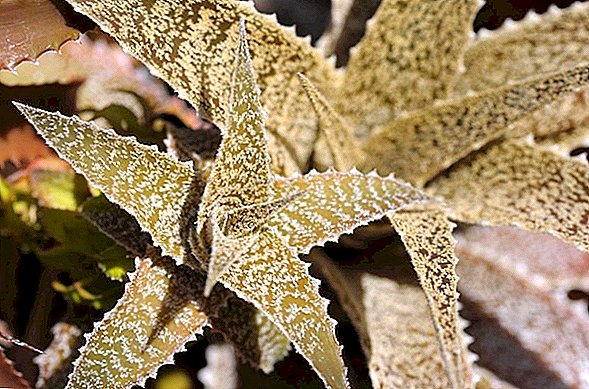
- Cryptanthus bivittatus (Cryptanthus bivittatus) - the plant has a compact size due to a height of 7-8 cm and short leaves, the length of which does not exceed 10 cm. The leaves of the flower are collected in small rosettes (about 15 cm in diameter) and have wavy edges with small teeth. Their surface is light green in color and covered with two longitudinal light stripes.

- Cryptanthus bromelioides - unlike other species, has a short stem and very bright leaves. Their color can be from green to coppery red with bright longitudinal white or green stripes. It can reach 30 cm in height, the length of the leaves is about 12 cm. The edges of the leaves are wavy and the tips are pointed.
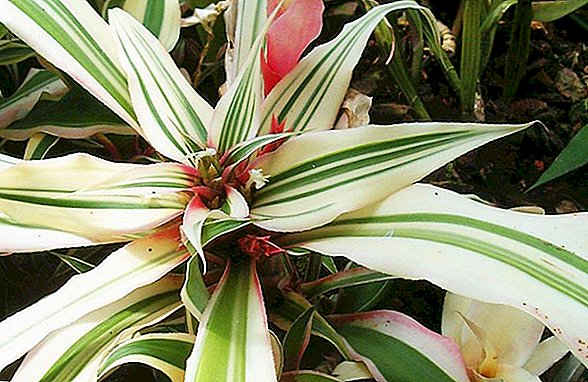
- Cryptanthus cross-striped (Cryptanthus zonatus) - its leaves are covered with transverse wavy strips of white or yellow color. The leaf shape is elongated, and its length can reach 20 cm. The leaves form a spreading socket with a diameter of about 20 cm.

- Cryptanthus fosterianus - one of the largest plant species, reaches a height of 35 cm. The flower has narrow leaves about 40 cm long with wavy, finely serrate edges. The color of the leaves is bright brown, and zigzag silver stripes are located across the leaf plate.
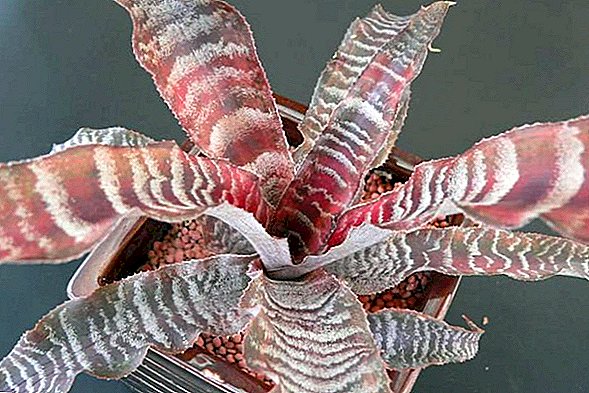
- Cryptanthus Red Star (Cryptanthus red star) - one of the brightest and miniature varieties of the flower. The leaves of the plant have a bright crimson color and contain a longitudinal dark green strip located in the center. The diameter of the outlet is only 15 cm. The edges of the sheet are wavy and painted in dark burgundy color.
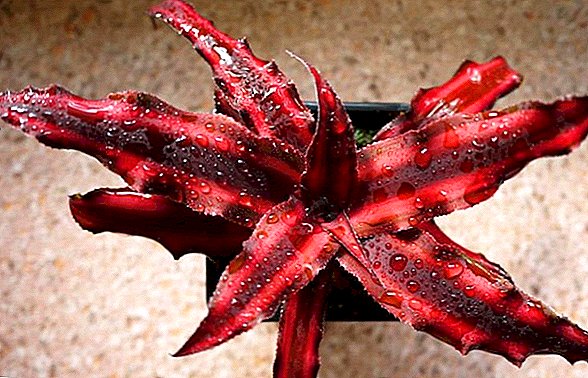
Conditions for successful home cultivation
Cryptanthus does not require specific growing conditions, but it requires a certain microclimate and suitable soil for normal growth and preventing the occurrence of diseases. The soil for the flower must be chosen loose, so that it absorbs water well and the roots of the plant can receive a sufficient amount of moisture and air. Let us consider in more detail the microclimate conditions for a flower in a room.
Location and lighting
Cryptanthus needs enough light. Especially important is good lighting for plant species with a colorful leaf color, as it allows you to save and better consider the pattern of stripes.
Important! At home, cryptanthus is best grown in closed or semi-closed glass terrariums or florariums.
The main lighting guidelines are listed below:
- Cryptanthus is recommended to be placed near the west or east window to provide it with a bright diffused light;
- the flower can not be put in direct sunlight, as this will lead to burns of leaves;
- the plant grows well in the penumbra, but with a lack of light, the color of its leaves turns pale;
- when the day is not long enough, you need to use artificial lighting - fluorescent lamps;
- The source of artificial illumination is placed at a distance of 0.5 m from the flower and includes at least 8 hours.
Air temperature and humidity
Under natural conditions, cryptanthus grows in a warm and humid climate, therefore, when it is grown at home, it is necessary to maintain a comfortable temperature for the flower and provide an adequate level of humidity. In a room with dry air, the leaves of the plant lose their decorative effect and begin to dry out.

The basic requirements for temperature and air humidity for a flower are listed below:
- in summer, it is recommended to keep the room temperature + 22 ... + 24 ° С;
- in late autumn and winter, the growth of the flower slows down, so the room may be + 18 ... + 20 ° С;
- the minimum temperature that cryptanthus can withstand is + 15 ° C, but only for a short period of time;
- temperature drops and drafts must be avoided;
- The level of air humidity should be about 60-70%.
To achieve a high percentage of air humidity, use a pallet with wet clay, which put a pot with a flower. A good effect is given by regular spraying of the leaves.
How to care at home?
Cryptanthus belongs to unpretentious in the care of domestic plants. The weak point of the flower is its sensitive and fragile root system, which requires careful treatment during transplantation and strict adherence to watering. And in order for the leaves of the flower not to lose their decorative appearance, it is necessary to fertilize in time. Next, we consider the basic rules of plant care.
Did you know? In terms of botany, cryptanthus is a distant relative of pineapple.
Watering
The flower reacts negatively both to an oversupply of moisture in the soil, and to its deficiency. Watering it should be plentiful, but only after the top layer of soil in the pot dries.
The basic rules for cryptanthus watering are listed below:
- only water of room temperature is suitable for watering the plant;
- spring and summer cryptanthus is watered plentifully with a frequency of 2-3 times a week
- autumn and winter watering should be more moderate - about 1 time in 10 days;
- water should be poured directly on the soil around the plant and make sure that it does not fall on the rosette of leaves - this can cause leaf rot;
- the excess water that flows into the pan must be drained half an hour after watering so that the water does not stagnate.
Top dressing
In the period of active growth and flowering cryptanthus needs feeding. It is best to use complex mineral fertilizer for flowering indoor plants, bought in the store.  The rules for feeding are listed below:
The rules for feeding are listed below:
- fertilizers are applied from April to September with an interval of 2-3 weeks;
- top dressing is made during watering in a dosage equal to half the recommended one on the package;
- the selected type of fertilizer should not contain calcium, and the amount of nitrogen in it should be minimal;
- in autumn and winter the flower falls into a state of rest, therefore fertilizers are not applied at this time.
Pruning
For the plant under consideration, slow growth is characteristic - for the year only 2-3 new leaves appear on the flower, so the cryptantus does not need pruning. In the case of drying out the tips of the leaves from an insufficient moisture level, you can cut off the yellowed part to preserve the decorativeness of the flower. Dry tips cut a little higher than where the green part of the leaf begins.
Transfer
You can repot the flower as needed, as soon as it becomes crowded in the old pot. This procedure is usually performed in the spring of 1 every 3-4 years, before flowering.
Important! Sometimes cryptanthus is grown on pieces of wood and snags. At the same time, its roots are wrapped in wet moss and securely attached to the support using wire.
Cryptanthus grows in height rather slowly, but expands in width, so you need to replant it in a shallow and wide pot. The diameter of the new pot should not exceed the size of the rosette of the flower, and there should be drainage holes on the bottom of the tank.
Cryptanthus is transplanted into loose and fertile soil.
You can buy ready-made substrate in specialized stores or cook at home from such ingredients:
- humus - 0.5 parts;
- moss - 1 part;
- leaf earth - 1 part;
- peat - 1 part;
- crushed pine bark - 3 parts.
Step-by-step instructions on plant transplantation are presented below:
- Prepare a low pot of suitable diameter and lay a drainage layer in it at a third of the height. As a drainage, you can use broken brick or expanded clay.
- Remove the plant from the old pot along with the earthy clod, trying not to damage the roots.
- Pass the flower into a new pot and add fresh soil to the container so that it is filled to the brim. Level the soil around the flower.

Breeding
The process of breeding cryptanthus at home is simple, and even a novice grower can make it. Usually, a new specimen is grown from seeds or from lateral processes of the parent plant. The main feature of reproduction is that for successful germination of seeds and rooting of shoots it is necessary to create greenhouse conditions and provide good lighting. Let us consider each of the listed methods of cryptanthus reproduction in more detail.
Lateral processes
After completion of flowering near the base of the cryptantus, you can see a lot of daughter processes - children. They rapidly grow several young leaves and in 1.5-2 months form small roots. These lateral processes can be used to propagate a plant.
Important! When planting the seed in the ground it is impossible to deepen its base too much into the soil - this can cause the development of root rot.
Step-by-step instructions for carrying out this process are presented below:
- Prepare small individual containers with soil mixture consisting of leafy ground, sand and small pieces of pine bark (in the ratio 3: 1: 1).
- Using a sharp knife, carefully separate the process from the parent plant along with the young roots. Place the cut to sprinkle with crushed coal.
- Dig a small depression in the soil and place the baby in it, sprinkle the roots with earth. Cover the container with film or glass.
- Put the pot with a process in a well-lit and warm room (+ 25 ... + 28 ° С). Make sure that the sapling does not fall into direct sunlight.
- Every day, open the film for 15 minutes to provide young plants with access to air.
- Water the seedlings with warm settled water as the topsoil dries.
- Planted kids will get stronger in about 3-4 weeks, after that the film is removed and taken care of the seedlings, like adult plants.
Video: Reproduction of cryptanus by cutting
Seeds
In specialized stores you can buy ready-made seeds of cryptanthus and grow a flower from them. It is recommended to plant seeds in the soil consisting of peat and sand in spring. When buying planting material, you need to select only the freshest seeds and process them with a weak solution of potassium permanganate before sowing.
Step-by-step instructions for growing cryptanus from seeds are presented below:
- Prepare small and shallow individual pots and fill them with soil.
- Lightly press the flower seed into the soil. Do not tamp the surface of the soil.
- Cover the container with the seeds with a film and put it in a well-lit place with an air temperature of + 26 ° C.
- Daily lift film for airing. Spray the soil with seeds as it dries.
- After the sprouts appear (in 10-14 days), the film is removed, and the capacity with the seedlings is kept away from drafts.
- After 3.5-4 months, when the leaflets grow 3-4 leaves, they dive into individual containers.

Possible problems with growing
If you provide the cryptanthus with the necessary care and create suitable microclimate conditions in the room, then you should not worry about the occurrence of diseases or pests. But if there are problems with growing a flower, you need to find out their cause and properly render the cryptanthus the necessary help.
Did you know? Cryptanthus is the smallest among all Bromeliads. Under natural conditions, its height is only 50 cm.
The list of possible plant diseases and pests is presented below:
- Root rot. It occurs when the soil is over-wetted, while the lower part of the plant and the base of the leaves begin to darken, the flower becomes sluggish. At the initial stage, cryptanthus can be saved by transplanting it into a fresh substrate and reducing watering. With a significant damage to the roots, you can only separate the children and grow from them a new plant.
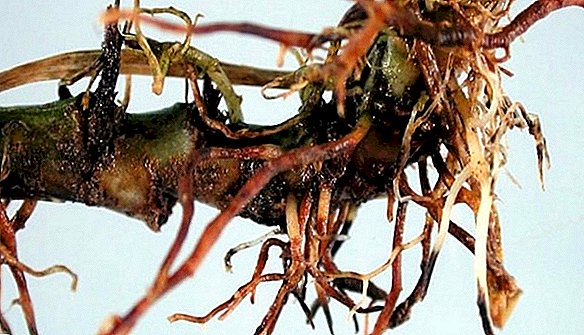
- Sunburn. They appear when the leaves of the cryptantus come into contact with direct sunlight. Brown spots appear on the surface of the plant, the leaf begins to dry. The yellowed edges of the leaf are cut, and the flower is prone to direct sunlight.

- White fly. Occurs in conditions of over-irrigation or over-spraying of cryptantus. Signs of its appearance are translucent larvae on the lower surface of the leaves, the presence of sticky plaque and black spots on the plant. To get rid of the pest, use chemical insecticides.

- Spider mite. Small dark spots appear on the leaves, and their lower surface is enveloped in a thin cobweb. The flower is cleaned of pests with a cotton swab dipped in soapy water, and then sprayed with insecticides.

- Shchitovka. This pest can settle on the leaves of the cryptantus and is of very small size. You can find it by the appearance of dark spots on the leaves, characteristic sticky plaque and insect accumulation on the lower surface of the sheet. To remove the pest, it is first removed from the leaves with a toothbrush, and then the flower is treated with special anti-insect drugs.

Cryptanthus can be a decoration of any interior due to its decorative appearance, colorful striped leaves. To do this, you need to create the conditions specified above in the article and follow simple rules for the daily care of the flower.
















